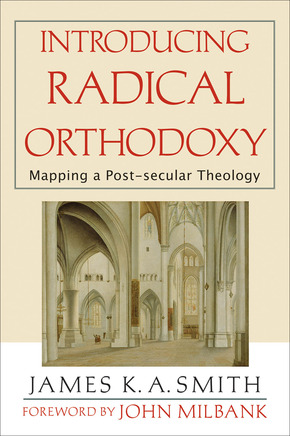Jamie Smith: Introducing Radical Orthodoxy
 James K.A. Smith, Introducing Radical Orthodoxy: Mapping a Post-secular Theology (Grand Rapids, Michigan: Baker Academic, 2004), 291 pages.
James K.A. Smith, Introducing Radical Orthodoxy: Mapping a Post-secular Theology (Grand Rapids, Michigan: Baker Academic, 2004), 291 pages.
Post-modernism is a philosophical perspective many Christians are now embracing in order to overcome the debilitating effects of modernity on the Christian church. What is refreshing about James Smith’s book is that he questions whether this approach is as helpful for Christian theology as it first appears. In fact, Smith proposes that post-modernism is in reality a continuation of the modernist project. This book offers an overview of the place of radical orthodoxy (RO) within the context of a post-secular/post-modern theological landscape. His aim is to draw together the thematic strands of RO in order to appraise its contributions to the theological enterprise and critique the misaligned assurance in the supposed neutrality of the modernist and post-modernist paradigms.
The book is divided into two sections. The first provides a map for understanding RO within the context of current theological trends. Smith suggests that four theological schools of thought have come to prominence. (1) The correlationist project emerged out of Tübingen (Germany) and made its way into the US through Union Theological Seminary (NY), The University of Chicago Divinity School (Chicago) and even ironically the fundamentalist school Dallas Theological Seminary (Dallas). This approach tries to correlate revelation with cultural, political and economic systems, and assumes the neutrality and universally accessible methods of the so-called “secular” sciences. (2) The Revelationist school is Barthian at root and has made its way from Basel (Switzerland) to Yale Divinity School (New Haven), Princeton (NJ) and Duke University (Durham, NC). This school highlights the antithesis between the gospel and culture, and therefore subverts all secular frameworks. The tendency in the Revelationist approach, though, is to jettison the secular sciences as irrelevant and focus exclusively on revelation claims. (3) The Neo-Calvinist school emerged in Amsterdam and has made its way into Calvin College (Grand Rapids) and the Institute for Christian Studies (Toronto). This approach represents an early post-secular critique, which is deeply suspicious of secular methods for arriving at knowledge and calls into questions the “sacred” tenets of modernity. (4) Finally, the Cambridge phenomenon of RO likewise emphasizes the antithesis between revelation and culture, but unlike the Barthian project’s abandonment of the secular, RO maintains there is no secular because even these methods presuppose faith commitments. For radical orthodoxy, all nature and culture is graced, but in need of redemptive transformation. RO is therefore critical of post-modernism because it is in reality a continuation of modernity.
Smith then outlines the theological contours of RO, which includes an ecumenism that transcends confessional boundaries, a retrieval of pre-modern sources and a hermeneutical disposition that seeks to be unapologetically confessional. Moreover RO is critical of modernity as a flawed system, because it reduces truth to a single system based on a notion of universal reason; RO is post-secular in the sense that it identifies secular reason as myth; as a theological movement it emphasizes participation and materiality, meaning that creation has to be understood as participating in and suspended from transcendence. This position fights against modernist and post-modernist notions that the world is self-contained and therefore without the need for the divine. In other words, nihilism (e.g. lack of transcendence) is questioned because it assumes that the universe is isolated and self-supporting. RO also emphasizes the sacramental, liturgical and aesthetic modes of worship as a consequence of the incarnation and participation in the divine. Finally, RO offers a cultural critique of the world in the hope for its redemptive transformation in all areas of language, history and cultural. Throughout the discussion, Smith draws upon the Dutch Reformed tradition to voice his agreements and disagreements with RO, arguing that the two disciples would benefit from fruitful dialogue.
Category: In Depth, Spring 2006


